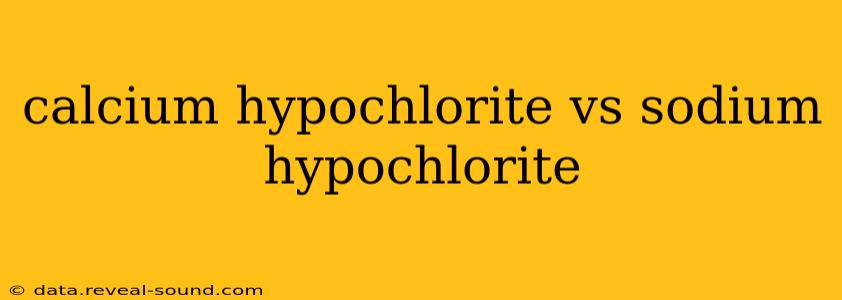Choosing the right disinfectant can be crucial, especially when dealing with sanitation in various settings. Two prominent contenders often top the list: calcium hypochlorite and sodium hypochlorite. Both are powerful chlorine-based disinfectants, but they possess distinct characteristics that make them suitable for different applications. This comprehensive guide will delve into the key differences, helping you understand which option best suits your needs.
What is Calcium Hypochlorite?
Calcium hypochlorite, often known as high-test hypochlorite (HTH), is a granular, white powder that's a highly concentrated form of chlorine. Its chemical formula is Ca(ClO)₂. This makes it incredibly effective as a disinfectant, offering a potent solution for various applications, but also requiring careful handling due to its strength. It's commonly used in swimming pools, water treatment, and industrial sanitation.
What is Sodium Hypochlorite?
Sodium hypochlorite (NaClO), better known as bleach, is a liquid solution widely available for household use. It's less concentrated than calcium hypochlorite, making it generally safer for domestic purposes but less potent for large-scale disinfection projects. It's commonly found in many households as a laundry additive and a cleaning agent.
Calcium Hypochlorite vs. Sodium Hypochlorite: Key Differences
Here's a table summarizing the key differences between these two disinfectants:
| Feature | Calcium Hypochlorite (HTH) | Sodium Hypochlorite (Bleach) |
|---|---|---|
| Form | Granular powder | Liquid solution |
| Chlorine Concentration | Higher | Lower |
| Stability | More stable in dry form, but degrades in solution | Less stable, degrades faster in sunlight and heat |
| Solubility | Less soluble in water | More soluble in water |
| Handling | Requires careful handling, safety precautions essential | Generally safer for domestic use |
| Cost | Can be more cost-effective per unit of chlorine | Typically more affordable per unit volume but less concentrated |
| Typical Applications | Swimming pools, water treatment, industrial sanitation | Household cleaning, laundry, some sanitation applications |
Which is More Effective? A Matter of Concentration and Application
The question of which is "more effective" isn't straightforward. Calcium hypochlorite offers a higher concentration of available chlorine, making it more powerful for larger-scale disinfection tasks. Sodium hypochlorite, while less concentrated, is often easier to handle and apply, making it perfectly suitable for everyday household cleaning. The effectiveness hinges on the specific application and the desired level of disinfection. A properly diluted solution of either can effectively sanitize surfaces.
What is the difference in chlorine content?
The chlorine content varies greatly depending on the specific product. HTH generally contains a significantly higher percentage of available chlorine (around 65-70%) compared to household bleach (typically 5-6%). This is a crucial factor determining its effectiveness for large-scale applications demanding higher concentrations of active chlorine.
Which is better for swimming pools?
For swimming pools, calcium hypochlorite (HTH) is often preferred due to its higher chlorine concentration and granular form, allowing for easier addition and consistent chlorine levels. However, proper handling and safety measures are essential.
Which is better for household cleaning?
Sodium hypochlorite (bleach) is generally safer and more convenient for household cleaning tasks. It’s readily available, easy to dilute, and effective against a wide range of bacteria and viruses. Remember to always follow dilution instructions on the product label.
Safety Precautions: Handling with Care
Both calcium hypochlorite and sodium hypochlorite are powerful chemicals that require careful handling. Always wear appropriate protective gear, including gloves and eye protection, when working with either product. Ensure adequate ventilation and avoid inhalation of the dust (HTH) or fumes (bleach). Never mix these chemicals with acids or other cleaning agents, as this can produce dangerous reactions. Always refer to the manufacturer’s safety data sheet (SDS) for specific handling and safety guidelines.
This information provides a general overview. Specific product instructions should always be followed carefully. For industrial or large-scale applications, consult with a professional for appropriate product selection and safety procedures.
